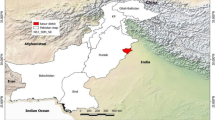Abstract
A study was conducted to determine the influence of forest road on breeding of tits in artificial nest boxes in deciduous, coniferous and mixed forests in the Gwanak Arboretum (37° 25′ 05′' N, 126° 56′ 85″ E) of Seoul National University, Anyang, Korea from November 2002 to June 2003. Three tits species, varied tit (Parus varius), marsh tit (P. palustris) and great tit (P. major), breeding in artificial nest boxes were investigated on number of breeding pairs, cultch size, and egg measurement. Resuls showed that the breeding pairs of varied tit was more in 75–150 m area than in 0–75m area from forest road for all the three study sites, and the clutch size and egg measurements (weight, Major axis and Minor axis) of varied tit was also higher in the area of 75–150 m than in the area of 0–75 m, while no differences in number of breeding pairs and clutch size were found for, marsh tit and great tit between the two areas. Egg measurement of great tit was also higher in forest interior area than in forest edge area. It is concluded that varied tit were most significantly influenced by forest road, followed by great tit, whereas marsh tit were not influenced by forest road. Artificial nest box is roved to be good for cavity nester in disturbed areas by human activities. Supply of artificial nest can help population protection and management of bird species.
Similar content being viewed by others
References
Eadie, J., Sherman, P. and Semel, B. 1998. Conspecific brood parasitism, population dynamics, and the conservation of cavity-nesting birds [M]. In: Caro, T. (eds.), Behavioral ecology and conservation biology, New York: Oxford University Press, p 306–340.
Matthew, R.E., Lank, D.B., Boyd, W.S. and Cooke, F. 2002. A comparison of the characteristics and fate of Barrow's goldeneye and bufflehead nests in nest boxes and natural cavities [J]. Condor,104: 610–619.
Nilsson, J.A. and Raberg, L. 2001. The resting metabolic cost of egg laying and nestling feeding in great tits [J]. Oecologia,128: 187–192.
Nour, N., Currie, D., Matthysen, E., Van Damme, R. and Dhondt, A.A. 1998. Effects of habitat fragmentation on provisioning rates, diet and breeding success in two species of tit (great tit and blue tit) [J]. Oecologia,114: 522–530.
Opdam, P. 1991. Metapopulation theory and habitat fragmentation: a review of holarctic breeding bird studies [J]. Landscape Ecology,5: 93–106.
Park, Y.S. 2003. A study of breeding ecology of tits in different forest types using artificial nest boxes [D]. Korea: MSc thesis of Seoul National University, Korea, 93pp.
Park, Y.S., Lee, W.S. Lee and Rhim, S.J. 2004. Differences in breeding success of tits in artificial nest boxes between hog fat supplied and non supplied coniferous forest [J]. Journal of Korean Forest Society,93: 383–387.
Purcell, K.L., Verner, J. and Oring, L.W. 1997. A comparison of the breeding ecology of birds nesting in boxes and tree cavities [J]. Auk,114: 646–656.
Riddington, R. and Gosler, A.G. 1995. Differences in reproductive success and parental qualities between habitats in the great tits (Parus major) [J]. Ibid,,137: 371–378.
Robinson, S.K., Thompson, F.R. III, Donovan, T.M., Whitehead D.R. and Faaborg, J. 1995. Regional forest fragmentation and the nesting success of migratory birds [J]. Science,267: 1987–1990.
Rytkonen, S. 2002. Nest defence in great titsParus major support for parental investment theory [J]. Behavioral Ecology and Sociobiology,52: 379–384.
Saracco, J.F. and Collazo, J.A. 1999. Predation on artificial nests along three edge types in a North Carolina Bottomland hardwood forest [J]. Wilson Bulletin,111: 541–549.
Saunder, D.A., Hobbs, R.J. and Margules, C.R. 1991. Biological consequences of ecosystem fragmentation: a review [J]. Conservation Biology,5: 18–32.
Suarez, A.V., Pfenning, K.S. and Robinson, S.K. 1997. Nesting success of a disturbance-dependant songbird on different kinds of edges [J]. Conservation Biology,11: 928–935.
Trombulak, S.C. and Frissell, C.A. 2000. Review of ecological effects of roads on terrestrial and aquatic communities [J]. Conservation Biology14: 18–30.
Zanette, L. 2002. What do artificial nests tells us about nest predation? [J]. Biological Conservation,103: 323–329.
Author information
Authors and Affiliations
Additional information
Biography: Young-Su Park (1976-), male, Ph. Doctor course student in Department of Forest Science, Seoul National University, 151–921, Seoul, Korea
Responsible editor: Chai Ruihai
Rights and permissions
About this article
Cite this article
Park, YS., Lee, WS. & Rhim, SJ. Influence of forest road on breeding of tits in artificial nest boxes. Journal of Forestry Research 16, 301–302 (2005). https://doi.org/10.1007/BF02858195
Received:
Accepted:
Issue Date:
DOI: https://doi.org/10.1007/BF02858195




